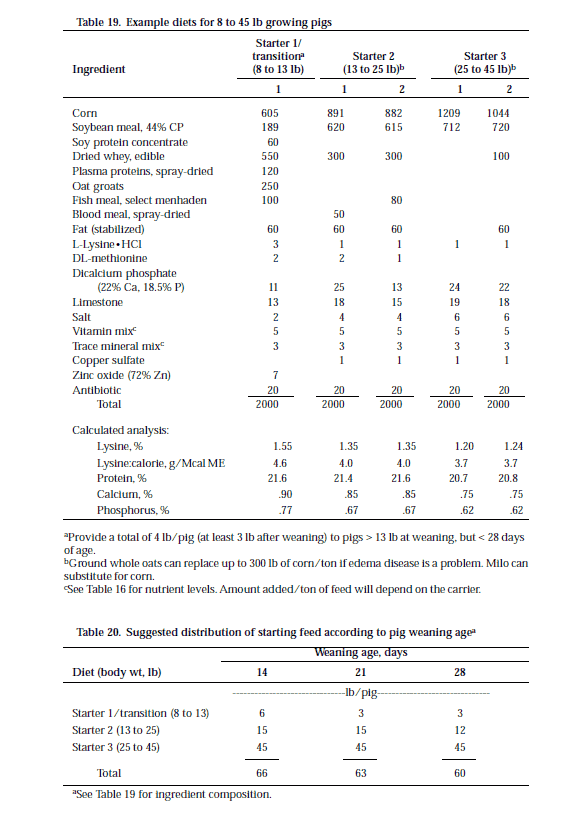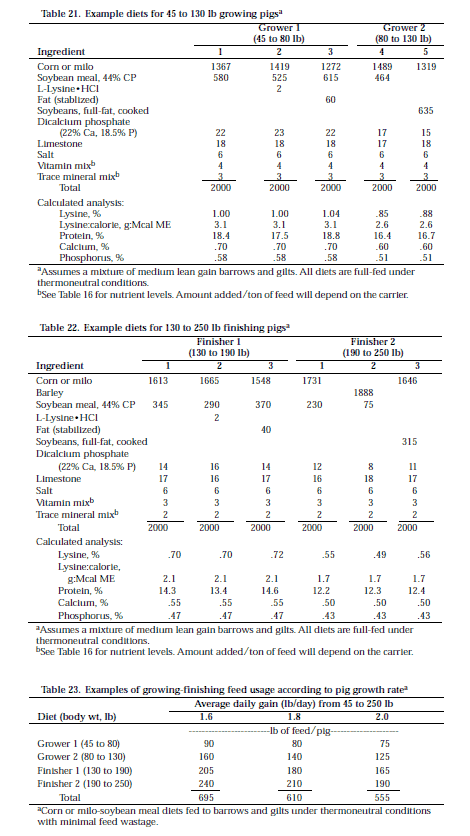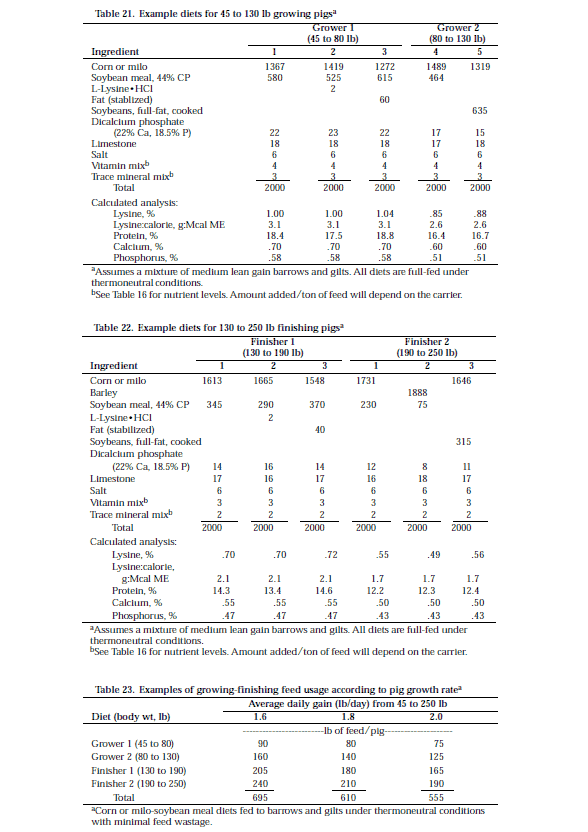Swine Nutrition Guide: Example Diets
Example Diets -- Example diets for all classes of swine are presented in Tables 19, 21, 22, 24 and 25. Ingredient analysis values in Table 29 were used to formulate the diets. Diets containing added fat were formulated to contain the same lysine:calorie ratio as diets without added fat. Fat reduces feed intake and unless the amino acid density is increased pig performance may be compromised due to a shortage of amino acids relative to calories. In general, these diets promote best-cost gain. Because ingredient price and availability are not constant, consider using alternate feedstuffs to optimize cost of gain. Refer to Tables 1 and 2 for guidelines when using alternate energy and protein sources.
Diets for 8 to 45 lb pigs
For reasons explained in the Methods of Supplying Nutrients section we recommend that most producers purchase complete pelleted diets for starting pigs weighing less than about 25 lb. We present example starting diets to show many of the typical ingredients used in starting diets today. It is necessary to use at least three different diets for starting pigs up to 45 lb to achieve good performance at low cost.
The starter 1/transition diet (Table 19) is a multipurpose diet. That is, it can be introduced to pigs before weaning as creep feed, fed to starting pigs from 8 to 13 lb body weight, or provided to pigs heavier than 13 lb at weaning. Creep feeding is recommended beginning at about 10 days of age for pigs weaned at 3 to 4 weeks of age and later. There is general agreement that a positive correlation exists between weight at weaning and subsequent performance.
Pigs that are heavier at weaning usually maintain their weight advantage to market weight. Therefore, creep feeding should be considered if it will result in a heavier pig at weaning. For pigs weaned at less than 3 weeks of age, the value of creep feed is questionable, because they often consume very little feed. The quality of the creep diet and how it is managed has a significant impact on whether creep feeding succeeds. Encourage creep feed consumption by providing small amounts of feed in a shallow pan or on the floor several times each day. Be sure the pigs have access to fresh water. Producers who wean pigs at about 2 weeks old (8 lb body weight) should feed the starter 1 diet until the pigs weigh about 13 lb. In addition, any pig that weighs more than 13 lb at weaning, but is less than 28 days of age, should be provided about 3 lb of the starter 1 diet before it is given the starter 2 diet. Body weight is not a good indicator of a weaned pig's ability to digest diets containing large amounts of the complex carbohydrates and proteins found in grain and soybean meal. Providing limited amounts of a highly digestible, nutrient dense diet after weaning helps pigs make the transition to dry feed. Table 20 shows suggested total intakes of each starter diet according to pig weaning age. Many producers control nursery feed costs by planning to feed a predetermined quantity of each diet. When the designated amount of a first diet is consumed, pigs are switched to the next, less expensive, diet in the sequence. It is important to monitor the weight of a few pigs chosen at random about every two weeks to determine if the pigs are growing as expected. Checking growth rate helps ensure pigs are switched to the next diet in the sequence at the proper time.

Diets for 45 to 250 lb pigs
Diets for growing-finishing pigs are shown in Tables 21 and 22. Table 23 presents examples of how feed during the growing-finishing phase may be distributed depending on the pigs' growth rate. Many producers switch diets according to estimated pig weight. An alternative method would be to provide a predetermined amount of each diet. When that amount is consumed, switch pigs to the next diet in the sequence. This eliminates guessing the weight of pigs to decide when to switch diets and the possibility of feeding higher nutrient dense diets too long. It is important to monitor the weight of a few pigs chosen at random every three to four weeks to determine if the pigs are growing as expected. Checking growth rate helps ensure pigs are switched to the next diet in the sequence at the proper time. Phase feeding is most convenient when facilities are operated on an all-in/all-out basis. Producers who have not fed pigs in this manner and who do not know the feed intake patterns of their pigs can use the information in Table 23 as a reference. Average daily gain data for growing-finishing pigs is needed to use Table 23.

Diets for the breeding herd
Suggested gilt developing, gestation, breeding boar, and lactation diets are shown in Tables 24 and 25. The gestation diets shown are designed to be fed so that sows receive 5.9 Mcal of ME/day. If a different amount of energy intake is required, reformulate the diets as described earlier. Feed used for the breeding herd will be about 2,200 lb/animal/year in well managed, confinement gestation units. That increases to about 2,500 lb/animal/ year in outdoor accommodations.

This article hasn't been commented yet.


Write a comment
* = required field